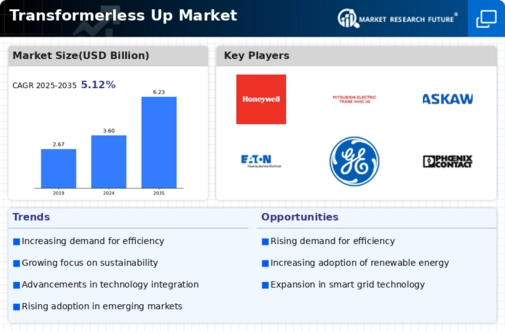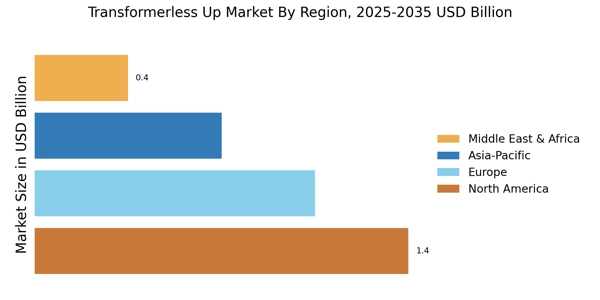Integration of Smart Technologies
The integration of smart technologies into the Transformerless Up Market is transforming how energy systems operate. With the advent of the Internet of Things (IoT) and advanced data analytics, transformerless systems can now offer enhanced monitoring and control capabilities. This integration allows for real-time data collection and analysis, enabling users to optimize energy usage and improve system reliability. The market for smart energy solutions is projected to grow significantly, with estimates suggesting a compound annual growth rate of over 20% in the coming years. As more industries adopt smart technologies, the Transformerless Up Market is likely to benefit from increased efficiency and reduced operational costs.
Rising Demand for Energy Efficiency
The Transformerless Up Market is experiencing a notable increase in demand for energy-efficient solutions. As energy costs continue to rise, consumers and businesses alike are seeking alternatives that reduce energy consumption without compromising performance. This trend is particularly evident in sectors such as manufacturing and commercial buildings, where energy efficiency can lead to substantial cost savings. According to recent data, energy-efficient technologies can reduce energy use by up to 30%, which is driving investments in transformerless systems. The growing awareness of energy conservation is likely to propel the Transformerless Up Market forward, as stakeholders prioritize sustainable practices and seek to minimize their carbon footprint.
Increased Investment in Renewable Energy
The Transformerless Up Market is poised to benefit from the increased investment in renewable energy sources. Governments and private entities are channeling substantial funds into renewable projects, which often utilize transformerless technologies to enhance efficiency and reduce costs. For instance, solar and wind energy systems frequently employ transformerless designs to optimize energy conversion. Recent reports suggest that global investments in renewable energy are expected to exceed several trillion dollars over the next decade. This influx of capital is likely to stimulate growth within the Transformerless Up Market, as stakeholders seek innovative solutions to meet the rising demand for clean energy.
Growing Awareness of Environmental Impact
The growing awareness of environmental impact is significantly influencing the Transformerless Up Market. As consumers become more conscious of their ecological footprint, there is a marked shift towards products and technologies that promote sustainability. This trend is driving demand for transformerless systems, which are often perceived as more environmentally friendly due to their reduced energy losses and lower emissions. Market Research Future indicates that a substantial percentage of consumers are willing to pay a premium for sustainable products, which is likely to encourage manufacturers to innovate within the Transformerless Up Market. This heightened awareness is expected to foster a more competitive landscape, pushing companies to adopt greener practices.
Shift Towards Decentralized Energy Systems
The shift towards decentralized energy systems is emerging as a pivotal driver for the Transformerless Up Market. As more consumers and businesses seek to generate their own energy through renewable sources, the demand for transformerless solutions is expected to rise. Decentralized systems, such as solar panels and wind turbines, often require transformerless configurations to enhance efficiency and reduce losses. This trend aligns with the broader movement towards energy independence and sustainability. Recent studies indicate that decentralized energy systems could account for a significant portion of energy generation in the near future, thereby creating new opportunities for the Transformerless Up Market.

















Leave a Comment